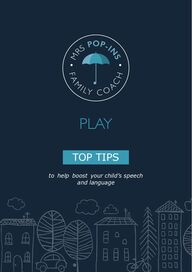
Return to flip book view
to help boost your child’s speech and languagePLAYTOP TIPSMRSPOP-INSFAMILYCOACH
PLAYPAGE OF CONTENTSEarly and imaginative playMappingLooking for learningTurn takingPLAY
MRS POP-INS PLAYEARLY ANDIMAGINATIVE PLAYPlay is important for language development and imaginative thinking. As children play they explore the world, and begin to understand more about how things around them work.ACTIVITIES TO TRY:• Collect a bag full of scrap materials (empty pots, shinypaper, bricks or spoons). Take time to explore thecontents of the bag. Make it fun by banging thingstogether, hiding items in pots etc.• Hiding games – cover toys with a scarf or sheet.Encourage your child to nd the toy.• Play games of throw and catch with a ball.• Play swinging and rocking games in the air or on theoor.• Collect boxes for your child to climb in and out of.Pretend the box is a house or a car.• Bounce your child up and down on your lap.
MRS POP-INS PLAYEARLY ANDIMAGINATIVE PLAYPlay is important for language development and imaginative thinking. As children play they explore the world, and begin to understand more about how things around them work.MORE ACTIVITIES TO TRY:• Collect items such as cups, brushes, hats, gloves or sponges. Pretend to have a drink, brush your hair etc. Encourage your child to copy you.• Role Play: Act out everyday situations together, such as talking on the phone or sweeping the floor. Then introduce toys that represent the real object. Try acting out everyday activities with dolls/teddies. For example, getting dressed, washing and eating. Talk about what you are doing and encourage your child to copy.• Play with miniature toys. To encourage the understanding of miniatures, play with the real objects and then the miniature. E.g., the child pretends to drink from a large cup then from a miniature cup (you may need to model drinking from the miniature). Play matching games, matching real sized and miniature objects.
MRS POP-INS PLAYMAPPINGMapping is the term used for commenting directly on your child’s actions and needs.HOW CAN YOU HELP?You can use mapping both during play sessions and to verbalise their needs. For example, if your child goes to the door and rattles the handle, say: “*their name* wants to go outside”, rather than “what do you want?” By doing this, you’ve acknowledged their attempt to communicate, shown they’ve got their message across, and given them a model of a better message.At play times, provide a quiet time and choose toys that are interesting but also invite sharing. Examples are: water play, cars and books. Don’t direct your child to a particular toy- try to follow their lead. Comment directly (in very short sentences) on your child’s actions but don’t ask questions.
MRS POP-INS PLAYLOOKING FOR LEARNINGThe aim of looking for learning is for your child to look in the direction that you are looking or pointing in, then look back at you for information about what you are looking at.HOW CAN YOU HELP?It’s a good idea to give the name of the item of interest before and after your child has followed your pointing. This allows you to reinforce what you are saying.ACTIVITIES TO TRY• Wait until your child looks at you. If they are notlooking at you, they may not be focused on what youare doing.• Tell them the name of an object or person.• Add a gesture if you need to, like pretending to drinkfor “cup” or making a beak shaped hand for “duck”.• Keep eye contact with them, then look and point in thedirection of the object.• Hold the point in place and glance back tocheck thatthey have followed your pointing.• If they look back at you, repeat again.
MRS POP-INS PLAYTURN TAKINGSome children find it difficult to wait, share and take turns. Turn-taking is an important skill to develop at an early stage to help develop the rules of turn-taking in conversations.HOW CAN YOU HELP?Before you do an activity, demonstrate it first. Make sure your child knows what to do. Indicate whose turn it is by saying e.g. “Mummy’s turn”, “Katie’s turn”, and use gestures if necessary. Using only a few key toys will help to focus on the activity.ACTIVITIES TO TRY• Balls – sit opposite your child and encourage them tothrow the ball back and forth.• Cars – take turns to roll cars to each other.• Take turns to post objects into a box.• Building beakers or bricks – take turns to add anotherbeaker or brick to the tower.• Lift out puzzles – take turns taking pieces out or puttingthem back in.• Musical instruments – take turns banging a drum orshaking a sealed pot of rice.• Skittles – take turns to roll the ball and knock downthe skittles.
MRS POP-INS PLAYTURN TAKINGMORE ACTIVITIES TO TRY• Cooking – take turns stirring the mixture.• Gardening – take turns to water the plants• Bath time – splash and wait for your child to copy you.• Let your child take the lead. Copy their actions e.g.clapping hands. Then stop, wait and see if they will doit again. Copy their sounds e.g. ‘mmm’, or noises e.g.‘brm brm’.• Lift the ap books – look at the pictures together. Taketurns to lift the ap.• Play peek-a-boo. Take it in turns to cover your eyes.
The Speech Language Communication CompanyT: 07307 924074 E: hello@s-l-co.uk www.s-l-co.ukCharity No. SC 046297MRSPOP-INSFAMILYCOACH